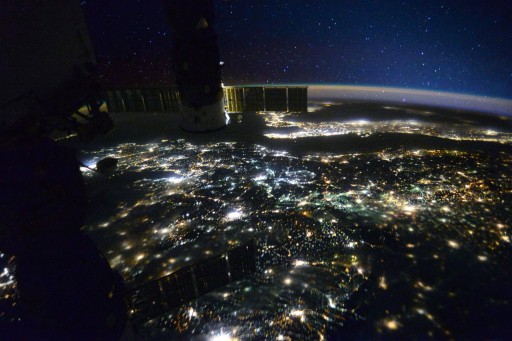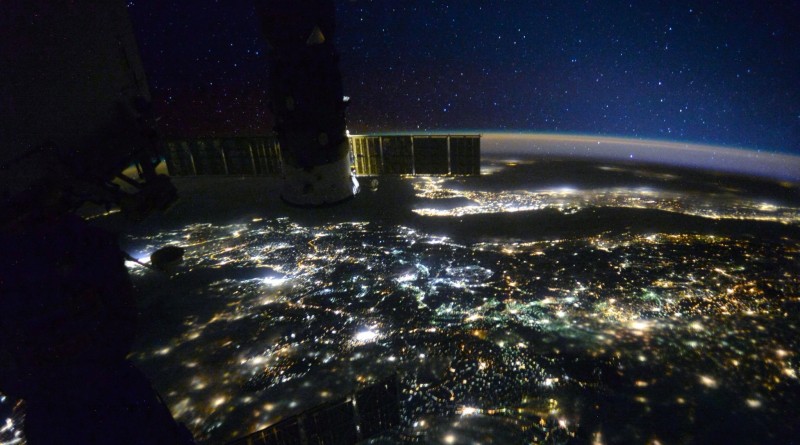ISS Operations Update – February 22, 2016

Experiments:
Sidekick Checkout [In use on ISS, the Sidekick (Microsoft HoloLens) hardware can be operated in Remote Expert Mode in which Skype is used to allow a ground engineer to see that the crew member sees which could ease real-time guidance when completing complex tasks including those for which no prior training on the ground was conducted. Also, ground team members could draw annotations into the crew member’s environment to help complete a task. In Procedure Mode, animated holographic illustrations can be displaced on top of objects a crew member is handling in order to lessen the amount of training future crews will require. This type of application could be of tremendous use in missions to more distant targets when communication delays complicate real-time ground support.]
ACE H2 – Sample Prep and Mixing [The Advanced Colloids Experiment will be performing a series of microscopic imaging investigations of materials which contain small colloidal particles. These materials have the specific characteristic of remaining evenly dispersed and distributed within the material. Performing these types of experiments aboard the Space Station in Zero Gravity allows scientists to separate the effects induced by Earth’s gravity in order to examine flow characteristics and the evolution and ordering effects within these colloidal materials. Results from this study will be used for a number of applications on Earth. ACE uses a Light Microscopy Module to monitor colloidal activity.]
Biochemical Profiles [The Biochemical Profiles study obtains blood and urine samples from long-duration space travelers before, during and after space flight to monitor specific proteins and chemicals that act as biomarkers and allow an assessment of particular biological, biochemical, biophysical processes that affect the health of a human. Conducting frequent sampling allows for the generation of a database of samples and test results which allows scientists to study the effects of spaceflight on the physiology of humans and it also allows an assessment of countermeasures associated with exercise and nutrition. The experiment consists of eight in-flight sessions comprised of a fasting blood draw and 24-hour urine collection. Body mass measurements on a monthly basis are also evaluated as part of the study.]
Cardio Ox – Sample Collection, Ultrasound Scans, Blood Pressure Measurements[„The purpose of this study is to measure levels of biomarkers in blood and urine that are affected by oxidative and inflammatory stress before, during, and after long duration spaceflight and relate them to the risk of developing atherosclerosis.“ (NASA)]
Integrated Resistance and Aerobic Training Study (Sprint) [This study evaluates a high-intensity, low-volume exercise protocol to minimize the loss of muscle, bone and cardiovascular function but also minimizing the time spent with daily exercise. To asses the protocol, crew members conduct regular measurements of VO2max, heart rate (HR) response to submaximal exercise and ventilatory threshold. Monthly ultrasounds of the thigh and calf are used to evaluate spaceflight-induced changes in the muscle volume. Post-flight data on muscle and bone mass is compared to pre-flight measurements and to data from control subjects that use the regular exercise protocol.]
Russian Joint Research (RJR) Microbiological Sampling
Otklik Experiment Hardware Check [Otklik uses several piezoelectric sensors to track the impacts of small particles and debris on the exterior of the International Space Station to monitor the abundance of debris events and a series of other characteristics. These measurements provide valuable data for the construction of future spacecraft]
Maintenance/Systems:
Nominal Inspections/Servicing Tasks (Morning Inspection, Caution & Warning Panel Check, Sozh System Maintenance) (Russian Crew)
OASIS Optics Repair [OASIS (Observation and Analysis of Smectic Islands in Space) will study the unique behavior of liquid crystals in microgravity with special focus on their overall motion and merging of crystal layers which is known as the formation of smectic islands. Studying liquid crystals in microgravity will provide new insights into two dimensional system physics of complex fluids. Findings may lead to understanding of well aligned, very high speed electro-optic devices that could find use in embedded ferroelectric liquid crystal micro-displays. The experiment assembly consists of a bubble chamber that is filled with medium, air jet injectors, ink injectors, LED lights and a camera assembly that monitors the activity inside the chamber. This setup will be used to study the various aspects of fluid crystal behavior in space – looking at overall fluid motion, diffusion, and the merging of crystal film layers.]
Urine Processing Assembly: On Saturday, the UPA experienced a fault due to belt slippage between the distillation assembly and its motor. Troubleshooting is in progress and the Waste and Hygiene Compartment is configured to use an external Urine Tank.
Water Processing Assembly (WPA) Catalytic Reactor Replacement Preparation
БМП Ф1 Micropurification Cartridge Bake Out
Test activation of Vozdukh Atmosphere Purification System Emergency Vacuum Valve
Other Activities:
Crew Departure Preparations
About Gagarin from Space – Educational Event
Progress M-29M Cargo Transfers

